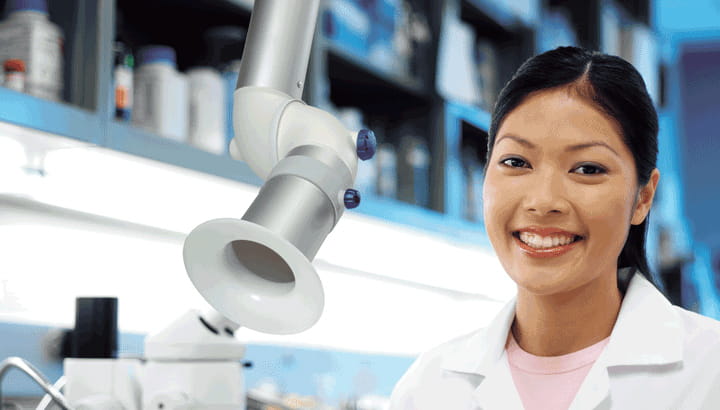
Many industries generate emissions that affect the air quality and the environment. Therefore, it is important to use equipment, such as an extraction arm, that can handle harmful fume, dust, gas and vapour. By using the extraction arm in an optimized way you can create a safer and more energy efficient workplace. In this blog article, you will learn how to maximize the efficiency of your extraction system.
Workshops, laboratories and industries producing electronics are examples of workplaces that often generate harmful dust, fumes and vapors. When the pollutants spread they can have a negative impact on both the facilities and breathing air. To maintain a safe and sustainable working environment it is important to use equipment that captures and filters the harmful emissions. The aim is to capture the particles or substances before they even reach the breathing zone or pollute the environment.
There are different kinds of local exhaust ventilation (LEV) equipment to use. A common example is an adjustable extraction arm that is positioned near the source of the pollution. The extraction arm can be highly efficient if it is used in the right way. The positioning of the extraction arm greatly impacts how well pollutants are captured. By optimizing the setting and position of the extraction arm you contribute to a safer workplace for yourself and your colleagues. In addition, you make it more energy efficient. If each extraction arm is capturing pollutants at maximum capacity, the number of required extraction arms can be decreased, which also decreases the productions energy consumption.
In other words, there are much to gain from a greater awareness in this area. So, what is the most efficient way of using the extraction arm then? To get to the bottom of that, Nederman got involved in a study at the Danish Technical University in Copenhagen. The study examined the efficiency of local exhaust ventilation in laboratories. Nederman contributed by giving the student interviews and extraction arms to be tested. Still, most of the results can be generalized and applied to other settings and extraction equipment as well. We learned a lot from the study and wanted to make sure that this knowledge also reaches the actual users of the extraction arms. Therefore, we compiled a whitepaper combining the main results from the study with our own experiences and expertise in the area.
There are many different factors affecting the efficiency of the extraction system. The air in a room is constantly moving due to, for example, general ventilation, cross-draught and operators’ movements. Therefore, these parameters must be considered when dimensioning and using the extraction system:
Once these things are considered, there are a few general guidelines to follow when positioning your extraction arm to maximize its capacity:
By following the recommendations above, factory managers and operators can greatly enhance safety and reduce energy consumption at their workplace. At Nederman, we believe it is important that the capturing equipment itself is easy to position and use. And, in addition, that the equipment has a good-looking design that suits the workplace. Therefore, we continuously develop our extraction arms and other capturing equipment to meet the market’s various needs. We hope that the tips above combined with a raised awareness and knowledge will contribute to a safer and more sustainable working environment for our customers.
I hope this blog article gave you some new insights on how to maximize the efficiency of your extraction systems. Do you want more in-depth information? Download our whitepaper "Improve Air Quality and Energy Efficiency by Optimizing Capture Efficiency with Nederman Articulated Extraction Arms". Also, feel free to contact us if you have any questions. We are happy to help you!
We have extensive experience of various challenges in the different industries and our experts are very skilled, helpful and professional. With us, you can feel secure that we take care of you and your needs. You are always welcome to contact us regardless if you have a short question or a more complex and complicated one. A warm welcome to Nederman.
Contact us here